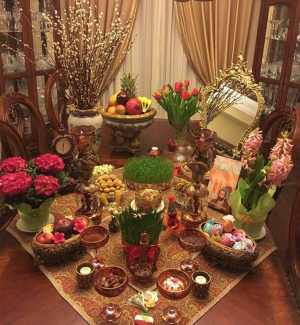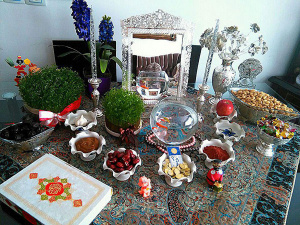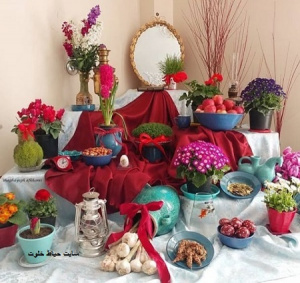Difference between revisions of "Language/Iranian-persian/Culture/Haft-sin"
m (Quick edit) |
|||
| (27 intermediate revisions by 5 users not shown) | |||
| Line 1: | Line 1: | ||
''' | <div class="pg_page_title">Haft-sin</div> | ||
[[File:هفت سین.jpg|thumb]] | |||
[[File:هفت-سین-96-9.jpg|thumb]] | |||
[[File:Sofre7sin.jpg|thumb]] | |||
<youtube>HZnoNXrkfO0</youtube> | |||
سلام Iranian Persian language and culture lovers! In today's lesson, you will learn about Haft-sin. | |||
'''Haft-sin''' (also spelled Haft-seen, Persian: هفتسین) is a traditional Persian table setting and custom practiced '''[[Language/Iranian-persian/Culture/Nowruz|Nowruz]]''', the Iranian New Year, which marks the beginning of spring in the Persian calendar. | |||
The celebration usually falls on or around March 21st. "Haft" means "seven" and "sin" refers to the Persian letter "س" (pronounced "seen"). | |||
The Haft-sin table displays seven symbolic items, each starting with the letter "seen," which represent various aspects of life and renewal. | |||
__TOC__ | |||
==Primary items== | |||
The following are the primary 7 items of Haft-sin, whose Persian names begin with the letter "س" in the Persian alphabet (pronounced as "seen"). | |||
# ''Sabzeh'' (سبزه) – wheat, barley, mung bean, or lentil sprouts grown in a dish. | # ''Sabzeh'' (سبزه) – wheat, barley, mung bean, or lentil sprouts grown in a dish. | ||
# ''Samanu'' (سمنو) – wheat germ sweet pudding. | # ''Samanu'' (سمنو) – wheat germ sweet pudding. | ||
# ''Senjed'' (سنجد) – Persian olive. | # ''Senjed'' (سنجد) – Persian olive. | ||
# ''Serkeh'' (سرکه) – vinegar. | # ''Serkeh'' (سرکه) – vinegar. | ||
# ''Seeb'' (سیب) – apple. | #''Seeb'' (سیب) – apple. | ||
# ''Seer'' (سیر) – garlic. | # ''Seer'' (سیر) – garlic. | ||
# ''Somāq'' (سماق) – sumac. | # ''Somāq'' (سماق) – sumac. ''SenjedSonbol''Somāq | ||
''SenjedSonbol''Somāq | |||
Coins (سکه ''sekke''), hyacinth (سنبل ''sonbol''), and clock (ساعت ''saat'') are sometimes included too. Other symbolic items that are typically used to accompany Haft-sin include a mirror, candles, painted eggs, goldfish, and traditional Persian confectioneries. | Coins (سکه ''sekke''), hyacinth (سنبل ''sonbol''), and clock (ساعت ''saat'') are sometimes included too. Other symbolic items that are typically used to accompany Haft-sin include a mirror, candles, painted eggs, goldfish, and traditional Persian confectioneries. | ||
| Line 15: | Line 30: | ||
A "book of wisdom" is also commonly included, which might be the Quran, the Bible, the Avesta, the Shahnameh, or the ''divān'' of Hafez | A "book of wisdom" is also commonly included, which might be the Quran, the Bible, the Avesta, the Shahnameh, or the ''divān'' of Hafez | ||
The Haft-Seen table represents nature. By tradition, Iranian families | The Haft-Seen table represents nature. By tradition, Iranian families make great efforts to create the most beautiful Haft-Seen table that they can. This is not only embody values both traditional and spiritual, it is but also appreciated by the visitors during Nowruz visiting exchanges as a reflection of the families' aesthetic sense and good taste. | ||
Items | ==Items starting "س"== | ||
Items starting with the Persian letter "س": | |||
* ''Sabzeh'' (سبزه): the symbol of rebirth and growth. | * ''Sabzeh'' (سبزه): the symbol of rebirth and growth. | ||
* ''Samanu'' (سمنو): the symbol of power and strength. | * ''Samanu'' (سمنو): the symbol of power and strength. | ||
| Line 25: | Line 41: | ||
* ''Seeb'' (سیب): the symbol of beauty. | * ''Seeb'' (سیب): the symbol of beauty. | ||
* ''Seer'' (سیر): the symbol of health and medicine. | * ''Seer'' (سیر): the symbol of health and medicine. | ||
Other items | |||
==Other items starting with "س"== | |||
Other items starting with the Persian letter "س" are sometimes included: | |||
* ''Sonbol'' (سنبل): the symbol of spring's arrival. | * ''Sonbol'' (سنبل): the symbol of spring's arrival. | ||
* ''Sekkeh'' (سکه): the symbol of wealth and prosperity. | * ''Sekkeh'' (سکه): the symbol of wealth and prosperity. | ||
* ''Saat'' (ساعت): the symbol of time. | * ''Saat'' (ساعت): the symbol of time. | ||
Items | |||
==Items not starting with "س"== | |||
Items not starting with "س" but, nonetheless, invariably included: | |||
* ''eggs'' (تخممرغ رنگی): the symbol of fertility. | * ''eggs'' (تخممرغ رنگی): the symbol of fertility. | ||
* ''mirror'' (آینه): the symbol of self-reflection. | * ''mirror'' (آینه): the symbol of self-reflection. | ||
| Line 35: | Line 55: | ||
* ''goldfish'' (ماهی قرمز): the symbol of progress. | * ''goldfish'' (ماهی قرمز): the symbol of progress. | ||
* ''book'' (کتاب): the symbol of wisdom. | * ''book'' (کتاب): the symbol of wisdom. | ||
==Other Lessons== | |||
* [[Language/Iranian-persian/Culture/The-Bakhtiari|The Bakhtiari]] | |||
* [[Language/Iranian-persian/Culture/Iran-Timeline|Iran Timeline]] | |||
* [[Language/Iranian-persian/Culture/Communicate|Communicate]] | |||
* [[Language/Iranian-persian/Culture/Castles|Castles]] | |||
* [[Language/Iranian-persian/Culture/Public-holidays-in-Iran|Public holidays in Iran]] | |||
* [[Language/Iranian-persian/Culture/Months-of-the-year|Months of the year]] | |||
* [[Language/Iranian-persian/Culture/Sizdahbedar|Sizdahbedar]] | |||
* [[Language/Iranian-persian/Culture/Nowruz|Nowruz]] | |||
* [[Language/Iranian-persian/Culture/Transportation|Transportation]] | |||
* [[Language/Iranian-persian/Culture/Iranian-calendar|Iranian calendar]] | |||
<span links></span> | |||
Latest revision as of 10:23, 27 March 2023
سلام Iranian Persian language and culture lovers! In today's lesson, you will learn about Haft-sin.
Haft-sin (also spelled Haft-seen, Persian: هفتسین) is a traditional Persian table setting and custom practiced Nowruz, the Iranian New Year, which marks the beginning of spring in the Persian calendar.
The celebration usually falls on or around March 21st. "Haft" means "seven" and "sin" refers to the Persian letter "س" (pronounced "seen").
The Haft-sin table displays seven symbolic items, each starting with the letter "seen," which represent various aspects of life and renewal.
Primary items[edit | edit source]
The following are the primary 7 items of Haft-sin, whose Persian names begin with the letter "س" in the Persian alphabet (pronounced as "seen").
- Sabzeh (سبزه) – wheat, barley, mung bean, or lentil sprouts grown in a dish.
- Samanu (سمنو) – wheat germ sweet pudding.
- Senjed (سنجد) – Persian olive.
- Serkeh (سرکه) – vinegar.
- Seeb (سیب) – apple.
- Seer (سیر) – garlic.
- Somāq (سماق) – sumac. SenjedSonbolSomāq
Coins (سکه sekke), hyacinth (سنبل sonbol), and clock (ساعت saat) are sometimes included too. Other symbolic items that are typically used to accompany Haft-sin include a mirror, candles, painted eggs, goldfish, and traditional Persian confectioneries.
A "book of wisdom" is also commonly included, which might be the Quran, the Bible, the Avesta, the Shahnameh, or the divān of Hafez
The Haft-Seen table represents nature. By tradition, Iranian families make great efforts to create the most beautiful Haft-Seen table that they can. This is not only embody values both traditional and spiritual, it is but also appreciated by the visitors during Nowruz visiting exchanges as a reflection of the families' aesthetic sense and good taste.
Items starting "س"[edit | edit source]
Items starting with the Persian letter "س":
- Sabzeh (سبزه): the symbol of rebirth and growth.
- Samanu (سمنو): the symbol of power and strength.
- Senjed (سنجد): the symbol of love.
- Somāq (سماق): the symbol of sunrise.
- Serkeh (سرکه): the symbol of patience.
- Seeb (سیب): the symbol of beauty.
- Seer (سیر): the symbol of health and medicine.
Other items starting with "س"[edit | edit source]
Other items starting with the Persian letter "س" are sometimes included:
- Sonbol (سنبل): the symbol of spring's arrival.
- Sekkeh (سکه): the symbol of wealth and prosperity.
- Saat (ساعت): the symbol of time.
Items not starting with "س"[edit | edit source]
Items not starting with "س" but, nonetheless, invariably included:
- eggs (تخممرغ رنگی): the symbol of fertility.
- mirror (آینه): the symbol of self-reflection.
- candle (شمع): the symbol of enlightenment.
- goldfish (ماهی قرمز): the symbol of progress.
- book (کتاب): the symbol of wisdom.
Other Lessons[edit | edit source]
- The Bakhtiari
- Iran Timeline
- Communicate
- Castles
- Public holidays in Iran
- Months of the year
- Sizdahbedar
- Nowruz
- Transportation
- Iranian calendar


